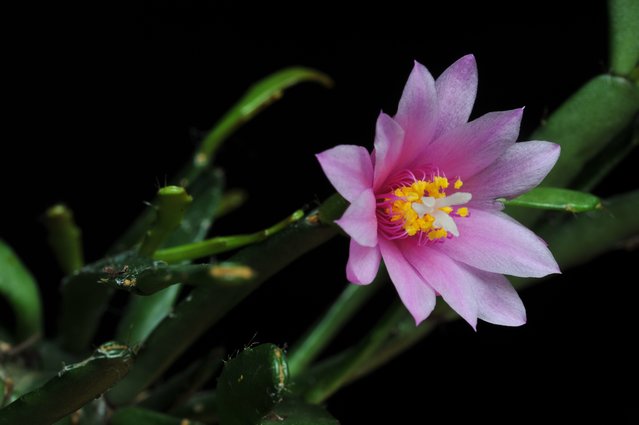** A METHOD **
** TO GROW CUTTINGS **
** IN WINTER **
____________________
CHAPTER 2
1-Rhipsalidopsis rosea : winter cuttings
artificial lighting and rooting in pure sand
_______________________________
I had a pot of Rhipsalidopsis rosea in my collection (This botanical species lives as an epiphyte on Araucaria trees in the rainforests of Brazil between 1000 and 2000m altitude). I had
photographed a flower in 2015 but the plant had since died.
Photo taken in 2015
A British reader wrote to me in November 2020 asking for a photo of this flower, as he did not have one to hand. However, he needed it to publish an article.
This reader offered to send me a cutting of the plant in exchange, which was an unexpected opportunity for me, as the plant is quite difficult to find.
So on December 26, 2020, I received a cutting of Rhipsalidopsis rosea from the UK. The period was not favourable, but the shipment was made before the BREXIT constraints required heavy formalities
that would have made it very difficult to formalities that would have made it very difficult to send the cutting.
When I received the cutting, I found it in my mailbox on the evening of 26 December 2020 and the outside temperature was 0°C. The package had taken more than 15 days to make its journey. I didn't
I didn't think it was going to make it in these winter temperatures. But the cutting was carefully wrapped in bubble wrap, which in turn was wrapped in a cardboard box, which in turn was wrapped in a
padded envelope.
When I opened it, the cutting appeared to be in good condition, turgid and rigid. I feared it was frozen and put it in my greenhouse at 12°C for observation. I cut it into three pieces to increase the chances of
chances of success. Several days later, it looked the same, so the frost hypothesis seemed to be excluded.
Unfortunately, you will not see the cutting when you receive it, as I did not photograph it.
I decided to take cuttings in a mini greenhouse heated by a double neon 6500°K (2x 55W) by simulating with a programmer days of 15 hours (from 7 am to 10 pm). I set the heating to have a temperature of about 20°C.
Installation of the turbo neon lights and the mini greenhouse
I used 3 square plastic pots of 10x10x12cm in which I put a layer of pozzolan of 1 cm granulometry at the bottom and I used an exclusively mineral substrate to fill the pots consisting of quartz sand (non
calcareous) of irregular grain size (about 0.2 to 1 mm). The sand, kept slightly moist, is an excellent rooting medium and reduces the risk of rotting compared to a standard substrate.
The sand, kept slightly moist, is an excellent rooting medium and reduces the risk of rotting compared to a standard substrate for epiphytic cacti.
Photos of the 3 pieces that were put on the sand on 30 December 2020, 4 days after their arrival.
As I was afraid of invisible underground rot in the wet sand before the root system was formed, I laid the cuttings horizontally on the ground. This was also done to take advantage of adventitious roots that
might have formed at the junction of the segments.
I watered by capillary action by partially immersing the pots in non-calcareous mineral water, but also by aerial spraying almost daily.
I made sure that the humidity of the sand was never excessive.
The following days showed me that no adventitious roots were forming.
Photo taken on January 6, 2021
The first roots formed at the base of the cuttings only
and not at the junction of the segments.
Photo taken on January 6, 2021
The first roots can be seen in the bulge forming at the base of this cutting.
(see inside the red circle)
Photo taken on January 10, 2021
A few days later, I observed the development of the roots.
I even observed the formation of flower buds which I cut off with great regret, as I did not want to exhaust the plant unnecessarily
Photo taken on January 10, 2021
Photo taken on January 14, 2021
Buds of new stems also formed, quite quickly. I have obviously kept them.
All this proved to me, and I was very surprised, that the plant had quickly returned to activity after being dormant for a short time before.
As I did not see any adventitious roots, I thought of tilting the cuttings into an upright position and supported them with small stakes.
When the cuttings were tilted, the root systems were about 1cm long and could therefore start to hydrate the cuttings.
Photo taken on January 18, 2021
(The cuttings have been placed in an upright position,
the one at the bottom has nothing to do with the article).
I continued watering at a rate of one watering per week, always watering from the bottom so that the bottom of the pot was wetter than the top and the roots were encouraged to stretch out to fetch water.
But the plants could not live in sand forever. After a month and a half of growing in sand, I let the sandy soil dry out and potted the cuttings in a nutritious substrate, which would be the substrate for several months.
___________________________________
BACK TO THE SUMMARY OF THE ARTICLE
_________________________________________
